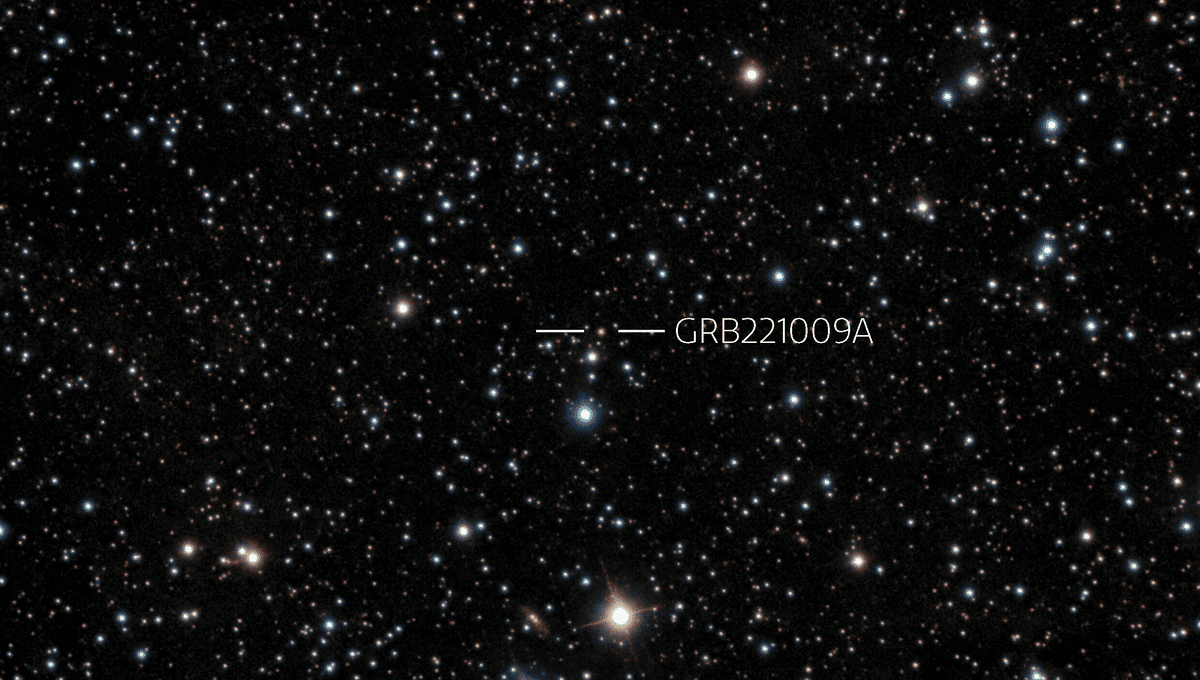
From nearly the first minute it was detected, astronomers knew the explosion named GRB221009A was something special. We’re now learning just how extraordinary it was – including detecting how it temporarily changed our planet’s upper atmosphere, affecting the passage of radio waves.
Gamma Ray Bursts (GRBs) involve possibly the greatest release of energy of any event in the universe. As the name suggests, most of the energy is released in the gamma-ray part of the spectrum, where our eyes cannot see it and our instruments have only recently become competent. The immediate cause is thought to lie in powerful jets released during the formation of black holes, but it’s possible not all of them come from the same type of event and different things may trigger black hole formation.
GRB221009A was picked up by X-Ray and Gamma-Ray satellite telescopes on October 9. Since then, instruments operating in other parts of the spectrum have tuned in to watch the afterglow. The nickname astronomers have given the event reveals the awe with which they regard it.
“In our research group, we’ve been referring to this burst as the ‘BOAT’, or Brightest Of All Time, because when you look at the thousands of bursts gamma-ray telescopes have been detecting since the 1990s, this one stands apart,” said Northwestern University graduate student Jillian Rastinejad in a statement. Rastomejad observed the fading event using the Giant Gemini South Telescope on October 14.
“The exceptionally long GRB 221009A is the brightest GRB ever recorded and its afterglow is smashing all records at all wavelengths,” said George Washington University’s Brendan O’Connor. “Because this burst is so bright and also nearby, we think this is a once-in-a-century opportunity to address some of the most fundamental questions regarding these explosions, from the formation of black holes to tests of dark matter models.”
The cause of the event is still unknown, but astronomers currently favor the explanation that a very massive star collapsed to form a black hole, and the accompanying jets blasted radiation in our direction.
Gemini South was just one of many telescopes to collect data on the event. A NASA archive lists 81 observations by dozens of observatories. Most other GRBs have just a handful.
Being so new, the observations’ meaning remains unclear, but some offer hints – including one that astronomers consider to possibly indicate signs of an emerging supernova. If so, it should allow us to discover what elements were produced in the explosion, filling in gaps in the origin of parts of the periodic table
A preprint has been uploaded to ArXiv.org reporting indirect detection of 18 Terra electronVolt photons. This is almost 50 percent more powerful than the highest energy photons produced at CERN, and around ten times the highest previous astronomical records. Existing instruments can’t collect photons this powerful, but when they hit the atmosphere, showers of lower-energy radiation give them away. Gamma rays in this range are expected to interact with background radiation and never travel anything like 2.4 billion light years, making the discovery a major puzzle.
Powerful GRBs have been found to affect Earth’s atmosphere before, so isn’t a one-off in that regard. Nevertheless, its BOAT status made the effect unmissable on devices recording the atmosphere’s ionization levels, rather than being hard to distinguish from background fluctuations, as has usually been the case before.
Unfortunately, the LIGO network, which has long breaks between its runs, is currently offline, so we didn’t get to see what gravitational wave the event produced.
Although 2.4 billion light years is a long way by almost any standard, the event occurred much closer to us in time than to the cosmic dawn. This indicates the most powerful bursts are not restricted to conditions shortly after the first stars formed, but can take place in the modern universe.
A planet on the other side of GRB221009A’s galaxy from the explosion would have been about 100,000 times closer to the explosion than we were. Provided it was similarly in line with the jets, it would be bathed in 10 billion times the radiation, which would probably have done more than ionize its atmosphere. It’s a dangerous universe we live in.
The 18 TeV photons are reported on ArXiv.org
Source Link: The Most Powerful Gamma-Ray Explosion Ever Detected Briefly Changed Earth’s Atmosphere